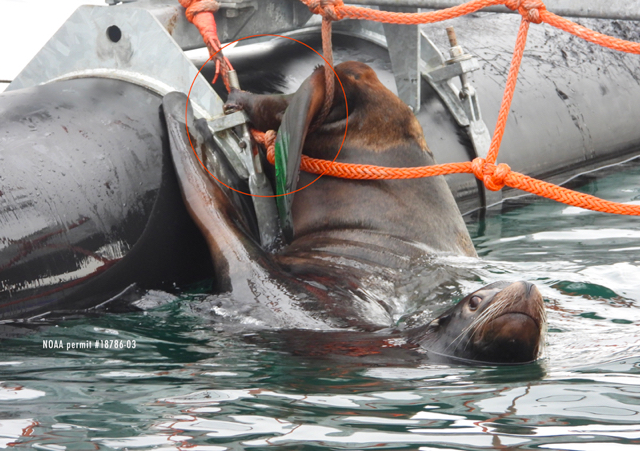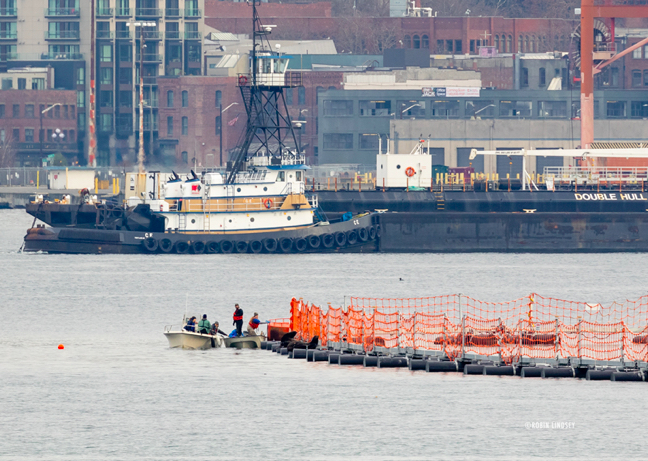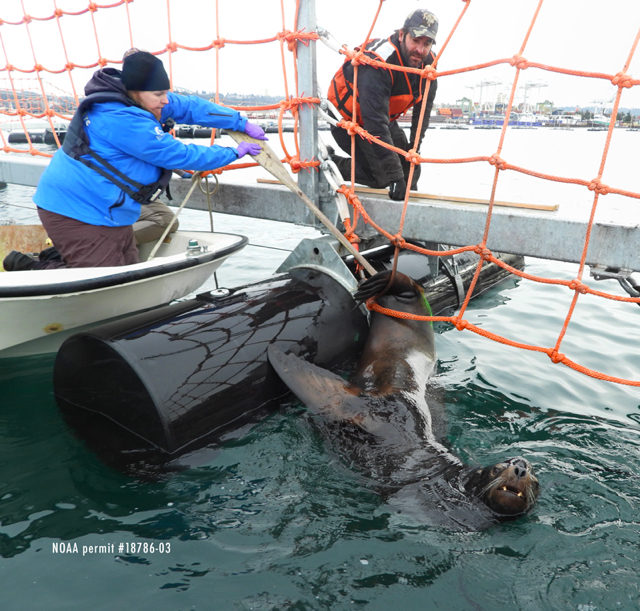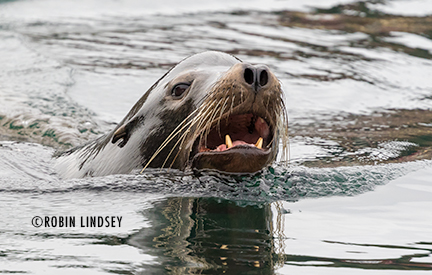sea lion
Sea lion impaled on bolt is freed by stranding team
Dec/22/19 08:29 AM
 FIRST RESPONDERS LAY GROUNDWORK TO RESCUE SEA LION FROM CERTAIN DEATH
FIRST RESPONDERS LAY GROUNDWORK TO RESCUE SEA LION FROM CERTAIN DEATHAt 3:54p on Tuesday, Seal Sitters MMSN hotline (206-905-7325) received a call from Global Diving and Salvage employee John Duerr, who reported a California sea lion impaled on a bolt attached to a barrel in Elliott Bay.The barrel supported a floating security fence at Vigor Shipyard, located on the north end of Harbor Island. Seal Sitters Co-Investigator Lynn asked if he could confirm the animal was alive and he said, yes, the animal was lifting its head out of the water to breathe. It was not known how many days the animal had been hooked and unable to free himself. Lynn hung up and called Co-Investigator Robin, who offered to contact Vigor’s security office to get access for responders.
Due to the size of the animal and precarious water-only access, we knew it would require a highly experienced response team. Lynn contacted Casey Mclean of SR3 for help while Robin notified WDFW Marine Mammal Investigation Unit’s Dyanna Lambourn. The reporting party was still on-site in his boat and texted photos, which were shared with Casey, Dyanna and WDFW's Steve Jeffries. Since it was already dusk, Casey and Dyanna made plans to respond the following morning if the sea lion was still there.
Over the course of the evening, Robin laid the groundwork with many calls to Vigor Security, getting permission to access the animal early Wednesday morning. Casey and Dyanna coordinated plans for the response, recruiting additional experts and volunteers.
RESCUE PROVES CHALLENGING, BUT ENDS WITH HIGH FIVES

The boats took off at 10:20 and the team was soon at the Harbor Island site in Elliott Bay (photo above). Due to limited space in the vessels, Robin and Lynn observed from the viewing platform at Jack Block Park.

The sea lion had likely hauled out on one of the flotation barrels supporting the fence and gotten pierced through the genital area by an exposed bolt. When the examiners approached, the animal became agitated. Dr Cathy King administered a sedative formulated for sea lions and the team backed off while the sedative took effect.
Then, Dr. Cathy and Jeff were able, with considerable effort, to hoist the hind flippers and free the impaled tissue from the bolt. The adult male sea lion was marked with green biodegradable paint for identification purposes. A reversal drug revived him in a few minutes. After swimming around, he went back to the fence, forced another huge sea lion off its barrel, and took his place. The team returned to Don Armeni at 11:30.
Based on exam prior to release of the sea lion, it appears that the exposed tissue in the wound was beginning to heal, indicating that he could have been there a number of days. Thankfully, Global was doing a check of the security fencing, noticed him among the numerous sea lions hauled out on the barrels and called Seal Sitters’ hotline.
Huge kudos to the rescuers, many of whom used their time off work for the opportunity to extricate the sea lion. All were part of NOAA’s Marine Mammal Stranding Network and supporting organizations. And we are so grateful to the Global Diving employees and the Vigor Shipyard security supervisors and crew for their help. It was truly a team effort to save this beautiful marine mammal from certain starvation and send him back to his watery home for the holidays.
Feeding sea lions and seals is illegal, harmful and dangerous
May/22/17 06:43 PM
The recent British Columbia incident where a California sea lion yanked a young girl off a commercial dock and into the Strait of Georgia has made international headlines. People had been feeding the sea lion bread (most decidedly not a sea lion staple food) minutes before the child’s clothing was grabbed; this, despite numerous signs clearly warning that feeding marine mammals was not permitted. The child, who had been perched on the edge of the pier at Steveston Fisherman’s Wharf, was quickly rescued from the water and did not appear to be injured.
 Sea lions are curious, gregarious, lively, loud and large (up to 1000 lbs). It goes without saying that they are wild animals and, as such, are unpredictable in their behavior. The blame for this unfortunate occurrence in Canada does not lie with the sea lion, who likely mistook the child’s light-colored dress for fish.
Sea lions are curious, gregarious, lively, loud and large (up to 1000 lbs). It goes without saying that they are wild animals and, as such, are unpredictable in their behavior. The blame for this unfortunate occurrence in Canada does not lie with the sea lion, who likely mistook the child’s light-colored dress for fish.
The high-profile story has raised public awareness about the hazards this type of feeding interaction poses to humans, but the dangers to marine mammals must not be overlooked.
It is illegal to feed marine mammals in the wild, both in Canadian and United States waters. Marine mammals are protected by U.S. Federal law, Marine Mammal Protection Act, from harm by humans. If you feed or attempt to feed a marine mammal in the wild you put yourself and the animal at risk of injury and may be investigated by NOAA’s Office for Law Enforcement (OLE) for marine mammal harassment.
There are many potential consequences to feeding wild animals. Altering a seal or sea lion’s behavior can prove harmful by interfering with their ability to hunt and feed. If conditioned to approach people and vessels for food, they are at increased risk of injury and death. Marine mammals are wild animals that normally feed on live fish that they hunt and catch on their own.
Feeding marine mammals can cause them to lose their natural wariness of humans or boats and condition them to beg for handouts instead of foraging for their normal prey. They can become sick if they eat food that is spoiled or food that is not part of their normal diet, or they can get injured if they are too close to boats. They may also begin taking bait and catch from fishing gear, risking injury or death by entanglement in or ingestion of fishing gear.
There have been cases of people being bitten by dolphins and sea lions that become aggressive while begging for food, being teased with food by people, or expecting a handout.
Help keep marine mammals safe - and wild. If you observe someone feeding a seal or sea lion, please call OLE’s national hotline at 1-800-853-1964 (information may be left anonymously).
UPDATE 5/28/17
At the urging of marine mammal specialists in media posts, the family was encouraged to seek medical treatment - and did - for mild abrasions suffered in the incident, as bacteria and disease can be transmitted by contact with marine mammals.

The high-profile story has raised public awareness about the hazards this type of feeding interaction poses to humans, but the dangers to marine mammals must not be overlooked.
It is illegal to feed marine mammals in the wild, both in Canadian and United States waters. Marine mammals are protected by U.S. Federal law, Marine Mammal Protection Act, from harm by humans. If you feed or attempt to feed a marine mammal in the wild you put yourself and the animal at risk of injury and may be investigated by NOAA’s Office for Law Enforcement (OLE) for marine mammal harassment.
There are many potential consequences to feeding wild animals. Altering a seal or sea lion’s behavior can prove harmful by interfering with their ability to hunt and feed. If conditioned to approach people and vessels for food, they are at increased risk of injury and death. Marine mammals are wild animals that normally feed on live fish that they hunt and catch on their own.
Feeding marine mammals can cause them to lose their natural wariness of humans or boats and condition them to beg for handouts instead of foraging for their normal prey. They can become sick if they eat food that is spoiled or food that is not part of their normal diet, or they can get injured if they are too close to boats. They may also begin taking bait and catch from fishing gear, risking injury or death by entanglement in or ingestion of fishing gear.
There have been cases of people being bitten by dolphins and sea lions that become aggressive while begging for food, being teased with food by people, or expecting a handout.
Help keep marine mammals safe - and wild. If you observe someone feeding a seal or sea lion, please call OLE’s national hotline at 1-800-853-1964 (information may be left anonymously).
UPDATE 5/28/17
At the urging of marine mammal specialists in media posts, the family was encouraged to seek medical treatment - and did - for mild abrasions suffered in the incident, as bacteria and disease can be transmitted by contact with marine mammals.







